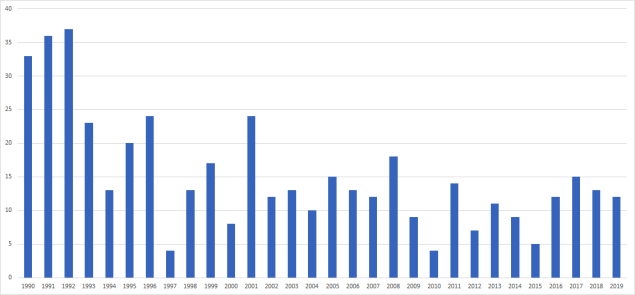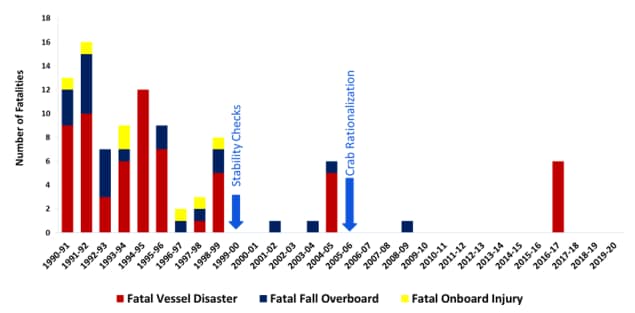Commercial Fishing Safety in Alaska

A photo of commercial fishing vessels tied up at the docks in Dutch Harbor, AK. Photo by NIOSH
NIOSH has been researching commercial fishing safety in Alaska since the early 1990s. While commercial fishing remains a high-risk occupation, the number of fishing fatalities due to traumatic injury in Alaska has decreased by 70% over 30 years (1990-2019). Safety improvements in Alaska occurred due to a combination of activities including safety regulations and fishery-specific interventions focusing on unique hazards of each fishery.
(Source: NIOSH Alaska Occupational Injury Surveillance System and Commercial Fishing Incident Database)

| Decade | Annual Average |
|---|---|
| 1990-1999 | 22 |
| 2000-2009 | 13.4 |
| 2010-2019 | 10.2 |
An example of this progress is reflected in the Bering Sea/Aleutian Island (BSAI) crab fleet, popularly known as the Deadliest Catch. This fishery had a fatality rate of 770/100,000 full-time equivalent workers (FTEs) in the late 1990s with an average of 8 deaths per year during seasons that lasted as few as 4 days. NIOSH identified the main cause of death as drownings after a vessel capsizing incident. The crab boats would lose stability due to overloading and icing of crab pots on their decks.
NIOSH presented the data to the US Coast Guard, who in 1999 instituted the preseason Dockside Stability and Safety Checks Program that checked the crab vessel’s pot load prior to leaving the dock. Like flipping a switch, the fatalities dropped from an average of 8 per year to less than 1 per year between 1999 and today.
In addition to the Coast Guard Compliance Checks, the BSAI crab fishery changed in 2005 from a derby-style race for fish to a quota-based (rationalized) system. This management change contributed to an extended fishing season, consolidation of the fleet, smaller pot loads, and allowed for a more experienced and potentially less fatigued crew.

| Fatalities by Incident Type | Top Three Causes of Death | Fisheries with the Most Fatalities |
|---|---|---|
| Vessel Disaster (103, 44%) | Drowning (180, 76%) | Salmon Drift Gillnet (30, 13%) |
| Fall Overboard (68, 29%) | Blunt Force Trauma (18, 8%) | Pot Cod (26, 11%) |
| Onboard Fatality (38, 16%) | Unintentional Overdose (11, 5%) | Sole Trawl (22, 9%) |
| Onshore Fatality (17, 7%) | Salmon Setnet (20, 8%) | |
| Diving Fatality (10, 4%) |
Summary of fishing fatalities in Alaska
Predictors of fishing vessel disasters in Alaska
Surviving fishing vessel disasters
Injuries and illnesses among Alaska’s commercial fishermen
PFD use in Alaska’s fishing industry
Developing an emergency-stop device for winches
See more research from Alaska and beyond on our Publications page.
